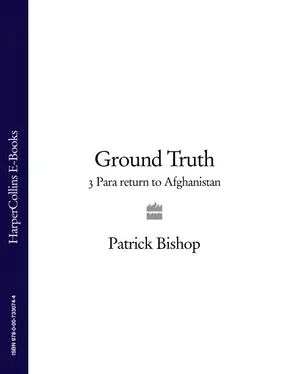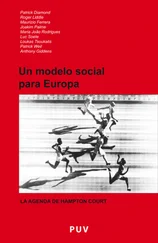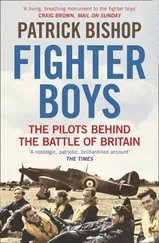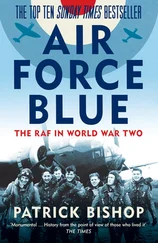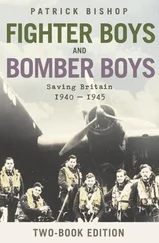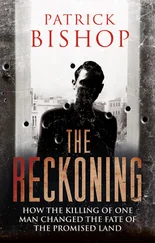GROUND TRUTH
3 Para: Return to Afghanistan
PATRICK BISHOP

To Douglas and Richenda
List of Illustrations
Maps
Introduction: A Big Ask
1 Going Back
2 Through the Looking Glass
3 KAF
4 Hearts and Minds
5 Hunting the Hobbit
6 Green Zone
7 IED
8 The Stadium
9 Facing the Dragon
10 Sangin Revisited
11 The White Cliffs of Helmand
12 Convoy
13 The Enemy
14 Close Quarters
15 Fields of Fire
16 ‘Something our Parents will Understand’
17 Homecoming
Abbreviations, Acronyms and Military Terms
Acknowledgments
By the Same Author
Index
Copyright
About the Publisher
The following account is based on interviews with the soldiers of 16 Air Assault Brigade. The author has made his best endeavour to report events accurately and truthfully and any insult or injury to any of the parties described or quoted herein or to their families is unintentional. The publishers will be happy to correct any inaccuracies in later editions.
Some names have been changed or omitted to protect operational security.
Brigadier Mark Carleton-Smith © Sergeant Anthony Boocock, 16 Air Assault Brigade photographer/Crown Copyright
Major Stuart McDonald © Tina Hager
Sangin schoolroom © Patrick Bishop
A Para leads women to safety © Jason P. Howe/ConflictPics
‘A’ Company patrols a poppy field © Captain Ian McLeish
Paras patrolling in Hutal © Tina Hager
Colour Sergeant Mark Kennedy with children in Qal-e-Gaz
© Captain Ian McLeish
‘A’ Company at a Maywand Base © Marco di Lauro/Getty Images
Paras navigating Maywand ditches © Jason P. Howe/ConflictPics
6 Platoon, ‘B’ Company patrol outside Hutal © Tina Hager
‘Gungy Third’ aboard a Chinook to Inkerman © Patrick Bishop
FOB Inkerman sangar sentry © Patrick Bishop
Privates Ben Biddulph and Andy Shawcross at Inkerman © Patrick Bishop
End of patrol at FOB Inkerman © Patrick Bishop
Sergeant Major Stu Bell © Patrick Bishop
Captain Ben Harrop © Patrick Bishop
Paras tabbing along a Mizan route © Christopher Pledger
Sergeant Chris Prosser at Inkerman © Patrick Bishop
Paras run to board a Chinook © Christopher Pledger
‘A’ Company prepare to assault © Captain Ian McLeish
Tabbing back to base in Zabul © Sergeant Ian Harding, 16 Air Assault Brigade Photographer/Crown Copyright
‘B’ Company patrol in Mizan © Christopher Pledger
Corporal Marc Stott © Patrick Bishop
Lieutenant Fraser Smith in Band-e-Timor © Patrick Bishop
Arrival at Kadahar Stadium © Marco di Lauro/Getty Images
Lance Corporal Andy Lanaghan with an ANA soldier
Paras patrol Kandahar City © Sergeant Craig Allen, Parachute Regiment Photographer/Crown Copyright
Bathing in the Sangin irrigation channel © Patrick Bishop
Sangin civilian © Patrick Bishop
Taking a breather in the Sangin Green Zone © Patrick Bishop
Corporal Mike French © Patrick Bishop
Corporal Bev Cornell © Corporal Bev Baljit Kaur Cornell
Corporal Marianne Hay with her dog Deanna © Patrick Bishop
HET tractor and trailer rig © Patrick Bishop
Satellite image of Kajaki dam by kind permission of Regional Command South
Major Stuart McDonald and Brigadier Huw Williams in Kajaki Sofia © Sergeant Anthony Boocock, 16 Air Assault Brigade photographer/Crown Copyright
Kajaki District Leader Abdul Razzak announces the ceasefire is off© Patrick Bishop
Major John Boyd © Patrick Bishop
A 500-pound bomb at Kajaki Sofia © Patrick Bishop
Corporal Stu Hale © Patrick Bishop
Flying the 3 Para flag © Christopher Pledger
Endpapers
‘A’ Company regroup after an air assault in Maywand © Jason P. Howe/ConflictPics
While every effort has been made to trace the owners of copyright material reproduced herein, the publishers would like to apologise for any omissions and would be pleased to incorporate missing acknowledgments in future editions.
| 1 Regional Command South |
xv |
| 2 Upper Sangin Valley |
xvi-xvii |
| 3 Kandahar |
xviii-xix |
| 4 Maywand |
xx-xxi |
| 5 Kajaki |
xxii |
| 6 Upper Gereshk Valley |
xxiii |
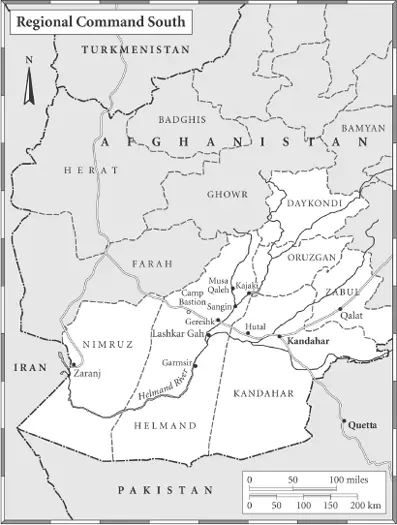
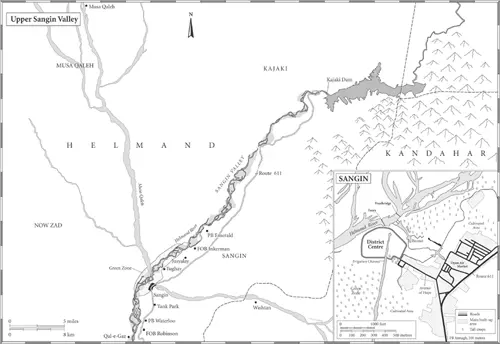
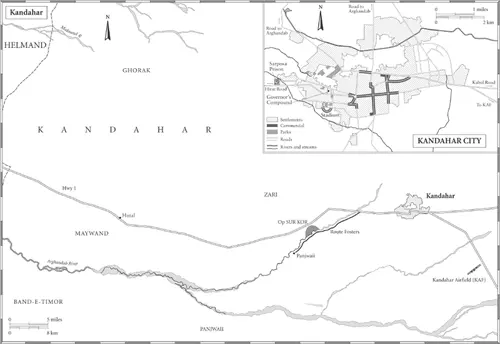
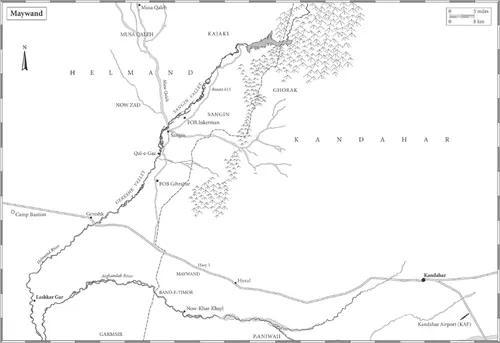
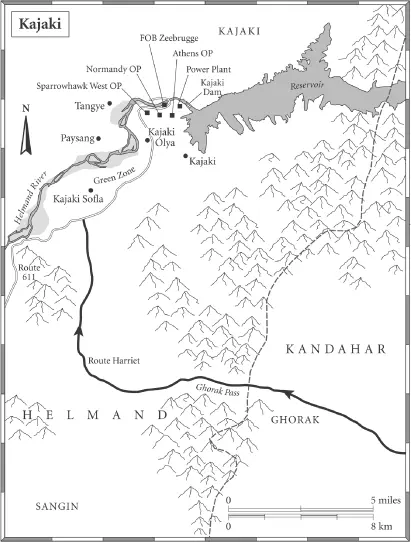
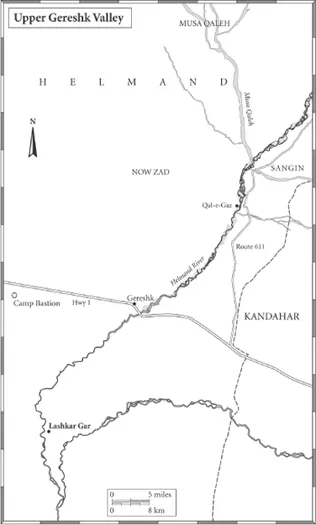
When 3 Para arrived back in Colchester in the autumn of 2008 after their second tour of Afghanistan in three years, their commanding officer, Huw Williams, pointed out the difference between his generation of soldiers and the very young men he was leading.
‘When I joined the army we thought we would have to go Northern Ireland and might possibly have to go somewhere else to fight,’ he said. ‘But these guys knew when they joined that they would be expected to go off, more or less straight away, to a full-on war.’
A British soldier’s job today is much more difficult and dangerous than it was in the last decades of the twentieth century. Then it was easily possible to go through an entire career without hearing a shot fired in anger. Now, a new recruit to a combat unit is virtually certain to see action. Thanks to Afghanistan, before long almost everyone will have a war story to tell. Since the British Army went there in force in 2006, about 40,000 servicemen and women have come and gone. That represents more than a third of the country’s ground troops. Some of them have now been twice. Force levels are rising steadily. There is no end in sight to the conflict and no obvious short cut that would allow an early but honourable exit. A spell in ‘Afghan’, as the soldiers call it, is becoming as routine as an Ulster roulement was thirty years ago.
There are some similarities. The skills and drills honed on the terraced streets of Belfast and Londonderry and the fields of Fermanagh and Tyrone have proved surprisingly useful in the river valleys of Helmand.
The differences, though, are far bigger. Ulster was grim, but Afghanistan is harrowing. The violence is deeper, darker and more disturbing. There were no suicide bombers in Northern Ireland. Life in Afghanistan’s front-line forts is harsh, squalid, exhausting and dangerous. Soldiers know that once they step through the gates they are facing six months of knackering patrols, regular fire-fights and the constant nerve-fraying fear that the next step they take may trigger a buried bomb.
Читать дальше
